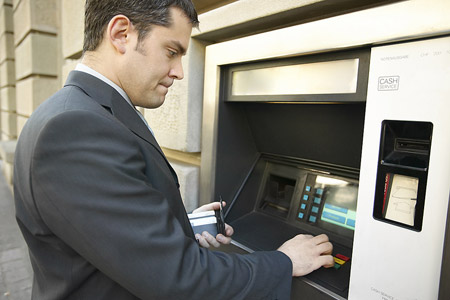ATMs and ATM Cards
We have referred to AMTs and ATM cards throughout this section, but we haven't really addressed what an ATM or an ATM card is used for. So...what is an ATM? Chances are you have seen your parents use an ATM or have even used one yourself. ATM stands for Automated Teller Machine, and it is basically a vending machine for money. ATMs can be found in many places, including banks, malls and airports.
 |
| ATMs provide banking convenience. |
To use an ATM machine an individual must have an ATM card and a PIN, or Personal Identification Number, associated with the card. A person can only access an ATM machine with an ATM card if he or she knows the correct PIN associated with the card. PIN TIPS: When choosing a PIN, pick a string of numbers that you will remember, but not something so obvious that other people can figure it out. Also, it is important not to share your PIN- even, with your friends!
When using an ATM machine, the card holder inserts the card into the machine and enters his or her PIN to gain access to a variety of transaction options offered by the machine and the bank the machine is conencted to. Typical transactions include: checking and savings deposit; checking and savings cash withdrawal; and checking and savings account balance.
ATM cards are provided to bank customers when they open ATM-enabled accounts. Most checking and savings accounts are ATM-enabled accounts; however, some accounts, such as a passbook savings account, are not ATM-enabled.
It is a good idea to use an ATM that is associated with your bank. If you do not, then you will most likely be charged an extra fee as most banks charge a fee for using an ATM associated with another bank. It is a good idea to open an account at a commercial bank that has a lot of ATM locations near your home, school and job. Some American banks even have agreements with banks in other countries so that if you visit someplace outside of the United States, you will not be charged for using the ATM.
ATMs are very convenient but it is necessary 1) to be aware of all fees (if any) associated with the ATM, 2) to record all transactions (withdrawals and deposits) that you make through an ATM, 3) to control your spending—sometimes ATMs make spending too easy and 4) to protect your ATM card and PIN to safeguard your account and your money.
- Always take your receipt with you from an ATM machine.
- Never give your PIN to anyone!
- If using the ATM at night, make sure to only go to one that is well lit.
- Always try to cover the keypad with your hand so that no one can see what your PIN is when you type it in.
 Further Your Understanding
Further Your Understanding
You can learn more about ATM scams here:
 Video: How ATMs Work
Video: How ATMs Work
Watch the following video to learn how an ATM works.